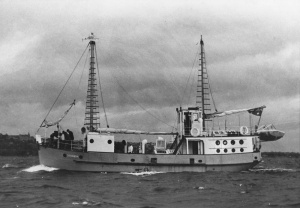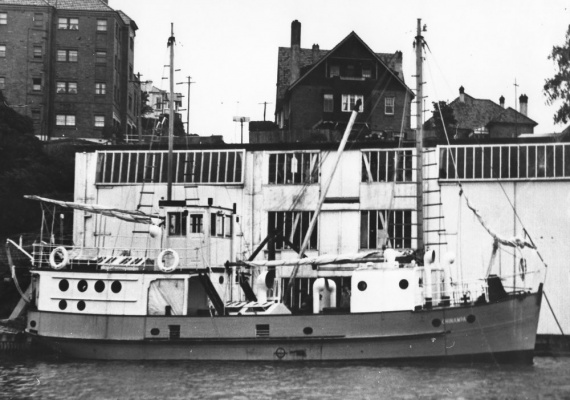HMAS Chinampa
| Type |
Auxiliary Ketch |
|---|---|
| Role | Stores Lighter |
| Pennant |
CP |
| Builder |
Lars Halvorsen & Son, Sydney, NSW |
| Launched |
1 February 1939 |
| Commissioned |
1 March 1942 |
| Decommissioned |
31 December 1945 |
| Fate |
Sold back to her original owners 21 February 1946 |
| Dimensions & Displacement | |
| Displacement | 60 tons |
| Length | 52 feet |
| Beam | 17 feet |
| Draught | 6.5 feet |
| Performance | |
| Speed | 7.5 knots |
| Propulsion | |
| Machinery | Vivian diesel engine |
| Horsepower | 80 hp |
| Armament | |
| Guns |
|
| Awards | |
| Battle Honours | DARWIN 1942-43 |
The auxiliary ketch Chinampa was requisitioned for naval service at Thursday Island on 18 February 1942. She arrived in Darwin on 28 February and commissioned the following day as HMAS Chinampa. She was purchased outright by the Commonwealth on 1 October 1942. Although she was officially classified as a stores lighter, she performed a wide variety of duties. She was engaged in general harbour duties in Darwin following her commissioning including the salvage of an aircraft at Bathurst Island in June.
On 28 July, Chinampa and the 300 ton motor vessel HMAS Southern Cross, embarked Australian troops for passage to Saumlaki on Yamdena Island, some 520 kilometres almost directly north of Darwin. By an unfortunate coincidence, their arrival at Saumlaki was preceded by a Japanese landing force which arrived before dawn on the 30th. Saumlaki's defending force consisted of thirteen Dutch soldiers armed with Tommy guns, a Lewis gun and hand grenades. The Dutch soldiers were expecting Chinampa and Southern Cross so the arrival of two ships in the harbour just after 04:00 was not unexpected. Around 300 Japanese soldiers alighted from the ships in boats and landed on the jetty. The tiny force of Dutch soldiers repelled the initial landing inflicting heavy Japanese casualties. Subsequent enemy landings, however, were made elsewhere while the Japanese ships opened fire on the defenders' position. Six of the gallant Dutch soldiers were killed and the survivors were driven into the bush. By 06:00 the town was in Japanese hands and the supporting ships departed shortly afterwards.
Chinampa and Southern Cross, meanwhile, were still some distance from Saumlaki and unaware that the town was now in enemy hands. At around 09:30 Southern Cross suffered an engine breakdown and Chinampa continued on independently. She anchored in the harbour that day and, expecting the small Dutch force to still be in control, her Commanding Officer, Commissioned Warrant Officer Frederick Henderson, RANR, went ashore but after being fired upon, rejoined his ship. When the more heavily armed Southern Cross arrived the next day, 31 July 1942, Chinampa proceeded to the jetty to attempt to land her troops but was forced to withdraw after coming under heavy fire which killed the 34 year-old Henderson and wounded two others. Chinampa and Southern Cross consequently withdrew without landing their troops, and returned to Darwin where they arrived on 2 August 1942.
The surviving Dutch troops, meanwhile, made good their escape to neighbouring Larat Island where they joined forces with other refugees. They, in a group of 36 which included two Australian soldiers, Netherlands East Indies troops, police and civilians, reached safety at Bathurst Island in a ketch on 14 August 1942.
Upon her return to Darwin, Chinampa was employed conducting harbour patrols, the transport of stores and other general duties, spending the remainder of the war in northern Australian waters. She salvaged two aircraft in the Wildman River in August and near Cape Dombey in October respectively, and conducted an operation to render mines safe in the vicinity of the Vernon Islands. The majority of 1944 and 1945 were occupied in the transportation of personnel and stores until she decommissioned at Thursday Island on 31 December 1945. She was sold back to her previous owners on 21 February 1946.





